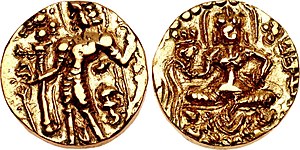| Kumaragupta II | |
|---|---|
 Kumaragupta II Kramaditya | |
| 10th Gupta emperor | |
| Reign | c. 473 – c. 476 CE |
| Predecessor | Purugupta |
| Successor | Budhagupta |
| Dynasty | Gupta |
| Religion | Hinduism [1] |
|
Gupta Empire 320 CE–550 CE | ||||||||||||||||||||||||||||||||||||
|---|---|---|---|---|---|---|---|---|---|---|---|---|---|---|---|---|---|---|---|---|---|---|---|---|---|---|---|---|---|---|---|---|---|---|---|---|
|
||||||||||||||||||||||||||||||||||||
Kumaragupta II (
Gupta script:
![]()
![]()
![]()
![]()
![]() Ku-ma-ra-gu-pta)
[2] Kramaditya was an emperor of the
Gupta Empire. An image of
Gautama Buddha at
Sarnath notes that he succeeded
Purugupta who was most likely his father.
[3] He was succeeded by
Budhagupta.
[4]
Ku-ma-ra-gu-pta)
[2] Kramaditya was an emperor of the
Gupta Empire. An image of
Gautama Buddha at
Sarnath notes that he succeeded
Purugupta who was most likely his father.
[3] He was succeeded by
Budhagupta.
[4]
Several statues of the standing Buddha, representative of Gupta art, are known from the reign of Kumaragupta II, now in the Sarnath Museum. [5] [6]
-
Buddha, standing under a chatra umbrella, inscribed: "Gift of Abhayamira in 154 GE" (474 CE) in the reign of Kumaragupta II. Sarnath Museum. [7]
-
Buddha, standing, inscribed: "Gift of Abhayamira in 154 GE" 474 CE in the reign of Kumaragupta II. Sarnath Museum. [8]
-
Inscription of the Buddha statue dated in Gupta Era 154 in the reign of Kumaragupta, with English translation. [9]
- ^ A History of Ancient and Early Medieval India by Upinder Singh p.521
- ^ Allen, John (1914). Catalogue of the coins of the Gupta dynasties. p. 142.
- ^ Agarwal, Ashvini (1989). Rise and Fall of the Imperial Guptas. Delhi: Motilal Banarsidass. pp. 220, 223–5. ISBN 81-208-0592-5.
- ^ The Gupta Empire by Radhakumud Mookerji p.107
- ^ "Collections-Virtual Museum of Images and Sounds". vmis.in. American Institute of Indian Studies.
- ^ "Collections-Virtual Museum of Images and Sounds". vmis.in. American Institute of Indian Studies.
- ^ "Collections-Virtual Museum of Images and Sounds". vmis.in. American Institute of Indian Studies.
- ^ "Collections-Virtual Museum of Images and Sounds". vmis.in. American Institute of Indian Studies.
- ^ Sahni, Daya Ram (1920). Annual Report Of The Archaeological Survey Of India 1914-15. p. 124 inscription XV.
| Kumaragupta II | |
|---|---|
 Kumaragupta II Kramaditya | |
| 10th Gupta emperor | |
| Reign | c. 473 – c. 476 CE |
| Predecessor | Purugupta |
| Successor | Budhagupta |
| Dynasty | Gupta |
| Religion | Hinduism [1] |
|
Gupta Empire 320 CE–550 CE | ||||||||||||||||||||||||||||||||||||
|---|---|---|---|---|---|---|---|---|---|---|---|---|---|---|---|---|---|---|---|---|---|---|---|---|---|---|---|---|---|---|---|---|---|---|---|---|
|
||||||||||||||||||||||||||||||||||||
Kumaragupta II (
Gupta script:
![]()
![]()
![]()
![]()
![]() Ku-ma-ra-gu-pta)
[2] Kramaditya was an emperor of the
Gupta Empire. An image of
Gautama Buddha at
Sarnath notes that he succeeded
Purugupta who was most likely his father.
[3] He was succeeded by
Budhagupta.
[4]
Ku-ma-ra-gu-pta)
[2] Kramaditya was an emperor of the
Gupta Empire. An image of
Gautama Buddha at
Sarnath notes that he succeeded
Purugupta who was most likely his father.
[3] He was succeeded by
Budhagupta.
[4]
Several statues of the standing Buddha, representative of Gupta art, are known from the reign of Kumaragupta II, now in the Sarnath Museum. [5] [6]
-
Buddha, standing under a chatra umbrella, inscribed: "Gift of Abhayamira in 154 GE" (474 CE) in the reign of Kumaragupta II. Sarnath Museum. [7]
-
Buddha, standing, inscribed: "Gift of Abhayamira in 154 GE" 474 CE in the reign of Kumaragupta II. Sarnath Museum. [8]
-
Inscription of the Buddha statue dated in Gupta Era 154 in the reign of Kumaragupta, with English translation. [9]
- ^ A History of Ancient and Early Medieval India by Upinder Singh p.521
- ^ Allen, John (1914). Catalogue of the coins of the Gupta dynasties. p. 142.
- ^ Agarwal, Ashvini (1989). Rise and Fall of the Imperial Guptas. Delhi: Motilal Banarsidass. pp. 220, 223–5. ISBN 81-208-0592-5.
- ^ The Gupta Empire by Radhakumud Mookerji p.107
- ^ "Collections-Virtual Museum of Images and Sounds". vmis.in. American Institute of Indian Studies.
- ^ "Collections-Virtual Museum of Images and Sounds". vmis.in. American Institute of Indian Studies.
- ^ "Collections-Virtual Museum of Images and Sounds". vmis.in. American Institute of Indian Studies.
- ^ "Collections-Virtual Museum of Images and Sounds". vmis.in. American Institute of Indian Studies.
- ^ Sahni, Daya Ram (1920). Annual Report Of The Archaeological Survey Of India 1914-15. p. 124 inscription XV.


![Buddha, standing under a chatra umbrella, inscribed: "Gift of Abhayamira in 154 GE" (474 CE) in the reign of Kumaragupta II. Sarnath Museum.[7]](https://upload.wikimedia.org/wikipedia/commons/thumb/0/0a/Buddha%2C_standing_under_umbrella%2C_inscribed_Gift_of_Abhayamira_in_154_GE_474_CE_in_the_reign_of_Kumaragupta_II.jpg/62px-Buddha%2C_standing_under_umbrella%2C_inscribed_Gift_of_Abhayamira_in_154_GE_474_CE_in_the_reign_of_Kumaragupta_II.jpg)
![Buddha, standing, inscribed: "Gift of Abhayamira in 154 GE" 474 CE in the reign of Kumaragupta II. Sarnath Museum.[8]](https://upload.wikimedia.org/wikipedia/commons/thumb/e/eb/Buddha%2C_standing%2C_inscribed_Gift_of_Abhayamira_in_154_GE_474_CE_in_the_reign_of_Kumaragupta_II_Sarnath_Museum.jpg/58px-Buddha%2C_standing%2C_inscribed_Gift_of_Abhayamira_in_154_GE_474_CE_in_the_reign_of_Kumaragupta_II_Sarnath_Museum.jpg)
![Inscription of the Buddha statue dated in Gupta Era 154 in the reign of Kumaragupta, with English translation.[9]](https://upload.wikimedia.org/wikipedia/commons/thumb/3/34/Buddha_inscription_of_Kumaragupta_in_Gupta_Era_154.jpg/120px-Buddha_inscription_of_Kumaragupta_in_Gupta_Era_154.jpg)